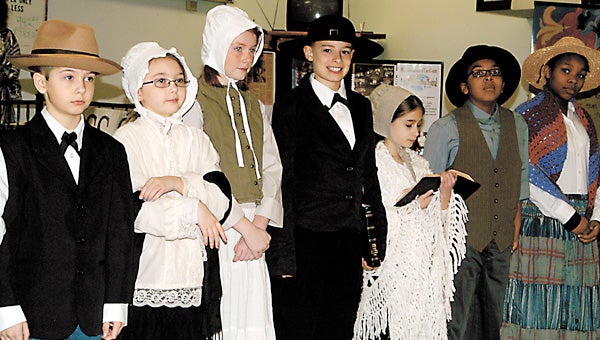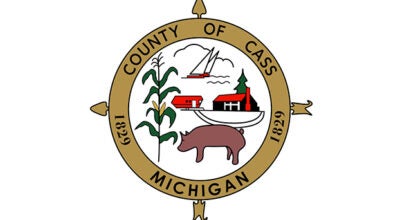Live ‘wax figures’ mark celebration of black history
Published 8:47 pm Wednesday, February 20, 2013

More than 40 fifth- and sixth-graders are come-to-life wax figures in a joint project by Cassopolis Public Schools and the Underground Railroad Society. Some are fifth-generation descendants of ancestors portrayed. They debuted at the Black History Month breakfast, which also featured a women’s musical tribute to Chain Lake Missionary Baptist Church. (Leader photo/JOHN EBY)
CASSOPOLIS — Cass County Minority Coalition combined a celebration of Chain Lake Missionary Baptist Church with the debut of the 45-member Underground Railroad “Wax Museum.”
The corps of period-garbed historical figures was composed of Sam Adams Elementary School fifth- and sixth-graders for Tuesday morning’s annual Black History Month breakfast at VFW Post 10704.
Some children are fifth-generation descendants of Underground Railroad figures they portrayed at the Bonine House in April.
Music was provided by Ross Beatty Junior/Senior High School choir, which will also perform at 7 p.m. Wednesday, and the Ross Beatty African American Club.
Chain Lake was Michigan’s first African-American church, incorporated before statehood.
With the theme “History Being Told,” Adrienne Glover traced why Black History Month, started as Negro History Week by Harvard’s Dr. Carter G. Woodson in 1926, takes place in February.
Woodson chose the second week of the second month because of two birthdays, Frederick Douglass and Abraham Lincoln. The 15th Amendment, granting blacks the right to vote, was ratified Feb. 3, 1870.
With W.E.B. Du Bois, born Feb. 23, 1868, as a co-founder, the NAACP was born Feb. 12, 1909.
“History tells us there were more than 3 million African-Americans who lived as slaves in the southern United States in the mid-1800s,” Glover said. “As a slave, you were considered property that belonged to your master.”
When they fled plantations, they hid by day and traveled at night by foot, “scared and afraid, many times carrying their babies and everything they owned on their backs” to reach northern states or Canada.
“It did not bother black Americans to be considered oppressed because they believed God is on the side of the oppressed. Their faith and strong belief in God gave them the determination to be free from persecution, beating, killings and chains,” which female vocalists literally cast to the floor with a clank.
A secret route
Slaves escaped by the Underground Railroad, a secret passage route which delivered more than 100,000 freedom-seekers.
Cass County figured prominently.
Quaker settlers sympathized with abolitionists and helped hide, feed and clothe slaves.
In the 1830s, Southern runaway slaves spirited to this area entered Michigan near Cassopolis, deciding they would be as safe in Cass County as Canada and taking refuge around Calvin Township.
Tough adjustment
“They found it difficult to adjust both socially and geographically,” Glover, assistant executive director of the Council on Aging, said.
“Having migrated from a warm climate, it was necessary to adjust to weather, soil and crop choices. They also found customs sometimes foreign to them as they were surrounded by communities of Quakers, Indians and blends of English, French and German descent. The Coloreds, as they were then known, were both helped and exploited.”
In January 1838, Rev. David Lett, Turner and wife Arena (Ash) Byrd, Harrison and wife Sarah (Robert) Ash, Wiley Madry, Irving and Dorothy James and Hartful Abrams incorporated Chain Lake.
Church was central to their lives. Glover said. “Early each Sunday morning, ladies dressed in their Sunday best, their crispy cottons and lace, stepped carefully into a buggy, drawn by horses, to journey miles, traveling narrow and dusty roads, carrying fresh butter, homemade bread and preserves and fried chicken, anticipating meetings friends and knowing their journey could last well into nightfall.”
Forty blacks freed upon the death of their owner, a Virginia planter, settled in Calvin, taking advantage of $4 to $5 an acre land. By 1846, there were an estimated 100 runaway slaves, mostly in Penn and Calvin townships.
A site was found in 1848 on top of a hill, surrounded by oak, maple, beech and hickory trees, for Chain Lake.
In the 1850s, a log structure was built to serve as a center for revivals and regular church services.
Michigan Anti-Slavery Baptist Association formed at Chain Lake in the wake of the Federal Fugitive Slave Act, with representation from Niles, Detroit, Battle Creek and Kalamazoo. After the Civil War, it became the Chain Lake Baptist Association.
Cobblestone steps and pillars built in 1856 still stand.
Sojourner Truth spoke at Chain Lake in June 1872, followed by Booker T. Washington in 1910.
Washington was visiting Studebaker and became curious about favorable comments he heard about Calvin Township’s black community.
A fence built to surround the cemetery promised a $5 fine for anyone caught hitching their horse to it as a way to raise funds.
Chain Lake helped organize Mt. Zion Baptist Church in South Bend, Ind.
Since 1921, Chain Lake has held an annual homecoming on the first Sunday in August.
The Rev. Boston Dyes became pastor in 1952. When he retired in 1983, the Rev. Norman Tubbs became pastor.
In 1960, the first program honoring Negro achievement was sponsored by Florilla Chapman, a Dowagiac teacher.
A fire Dec. 14, 1966, leveled the church. Worship temporarily took place in Carlisle’s sale barn. Construction of its replacement began June 26, 1967. On July 21, 1968, they marched to the new church, which was officially dedicated Nov. 29, 1968. In the late ’60s, members split off to form Calvin Chapel and Bethel AME Church.






